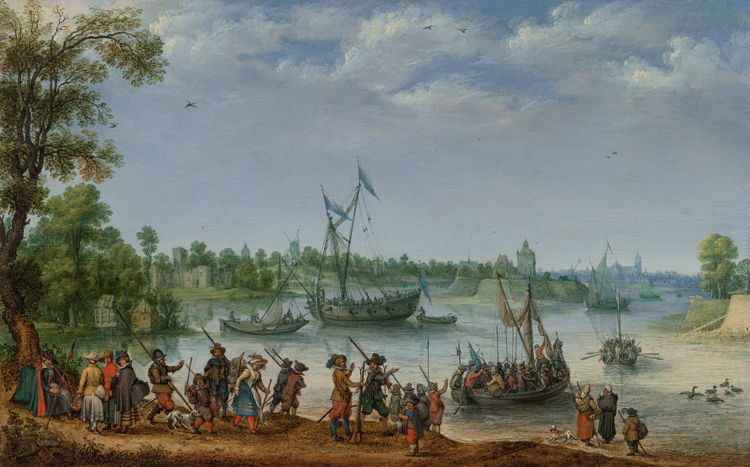When I was in second grade, my class spent the fall preparing for a play: a kid-friendly, historically inaccurate depiction of Christopher Columbus meeting Native Americans in the “New World,” the Pilgrims arriving in Plymouth, and how we eventually ended up with Thanksgiving. The short play attempted to cover about two hundred years’ worth of history. One of my classmates was selected to take on the role of Columbus; the rest of us were split between playing Pilgrims and Wampanoag people. No one knew or talked about what really happened when colonizers came to the Americas—especially not in 2008, when I took the stage wearing a homemade Native American headdress made from a paper grocery bag, craft feathers, and finger paint.
I was reminded of my second-grade production when I first saw Adam Willaerts’s painting The Departure of the Pilgrim Fathers from Delfshaven on their Way to America (1620). At first glance, the painting is a landscape; the majority of the image is taken up by ships on pale blue water, with a pastel sky to match. It’s a soft piece, the only sharp lines coming from the ship masts on the horizon. As I continued to look at the image, I noticed one of the ships was overflowing with people, minuscule in comparison to the scene around them. When my eyes moved to the shore in the foreground, I noticed another group, socializing and moving toward the water. The wall text next to the painting clarified that these were Pilgrims beginning their journey to America. They would eventually settle in Plymouth, Massachusetts. I looked more closely at the Pilgrims. At the water’s edge, they were accompanied by their dogs and children. They carried bags and walking sticks, but also human-sized guns and spears. It was jarring to see weapons in an image I originally found serene, held by Pilgrims, whom I once understood to be harmless, adventurous people. Beneath my perception of peace was a reality of violence toward Native communities.

Aside from a history of physical violence and displacement, European colonists’ attempts to “civilize” Native Americans through “Indian boarding schools” since the late 1800s and poor living conditions on reservations up to the present have contributed to a perpetual silencing of Native communities. Native voices are out there, but we need to prioritize them over the white voices that have claimed to speak for them for so long.
My school play didn’t mean much to me when I was seven. After we performed the twenty-minute skit for our parents, I thought Columbus was a pretty gutsy guy who helped bring worlds together. As I grew up, though, I began to realize how little I knew about Native American cultures—and, in comparison, how much I knew about the history of European “explorers.” It wasn’t until I did my own research in high school that I began to learn of the effect the Pilgrims’ search for religious freedom had on Native Americans. Although the Pilgrims exercised their newfound liberty, they also forced their religion on Native communities. I didn’t find this more accurate history in a classroom until I got to college. It wasn’t until I saw Willaerts’s painting and read its wall text that I learned Algonquian people lived on the land we now call Plymouth, Massachusetts—where the Pilgrims eventually made their new home, about an hour drive from the MFA. This small piece of information reframed how I saw and thought of Willaerts’s picture, filling in gaps of history I didn’t learn as a kid.
In its current display in MFA Boston’s Dutch and Flemish Art galleries, The Departure of the Pilgrim Fathers allowed me to reexamine the history I’d been taught. But I wonder why my younger relatives still learn about fictionalized stories of colonizers rather than Native American histories, which continue to be erased from our schooling. Why did I have to learn about colonization from a Dutch painting and not through the artwork and voices of Native American people? In acknowledging the story of colonialism through the presence of white, European art, we must also acknowledge the forced absence of Native American voices.
